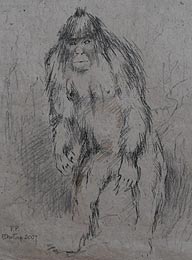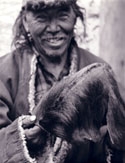
June 2, 2008


An article entitled “Yeti ‘photo-fit’ shows ‘potentially explosive’ evidence of elusive mountain beast” by Richard Holt, in London’s The Telegraph for 2 June 2008, has noted, with some excitement, that wildlife painter Polyanna Pickering has been shown what is believed to be “a 100-year-old Yeti scalp at a remote monastery in the Himalayas.”
Based upon Pickering’s viewing of the “scalp,” she has sketched (see example above) a drawing, which is being called “a ‘photo-fit’ of the Yeti based on ‘potentially explosive’ new evidence of the elusive creature’s existence.”
Pickering was collecting material for her planned new exhibition, while she was in the remote Bhutan region of the Himalayas. She made her chance discovery with a little help from David Beckham. The scalp was housed in a part of the monastery (she told the media was) closed to visitors, and since photography was banned too, Pickering, 65, made a rough sketch of the scalp. She produced a full drawing of the Yeti, there, based on scores of eyewitness accounts by local peoples.
I was told this was from a Migoi – their name for the Yeti. All I know is, it was bigger than any human or ape scalp I have ever seen. It had tufts of reddish-black fur coming out of it and was mounted on a pole and seen as a holy relic….The sole occupant was a caretaker monk who got very excited when he found out we were English and he was a huge David Beckham fan and then ushered us through to the back….I was amazed when they told me of regular sightings, close encounters and even tales of people being carried off by the Migoi. Their descriptions were so detailed, I ended up doing this ‘photo-fit’ with them all sitting round telling me to alter this or how that should look.Polyanna Pickering told the press
What occurred next is rather typical of the media. They asked someone for an opinion, took that opinion, and jumped to the conclusion that this was “the most important proof yet that the giant apelike beast is more than mere folklore.”
Even though the exact site of the scalp was not revealed, and in spite of the fact most monasteries tell visitors that the scalps are “off-limits” to visitors, we are left with speculations about this one that go beyond what is known. If no photographs were taken and Pickering was only allowed to make sketches, how do we know what she actually saw?
Yet, in an interview published in The Telegraph, Jon Downes, director of the Centre of Fortean Zoology, is quoted as stating this is a “unique” discovery “because the scalp still had a portion of bone attached to it.”
This fact is only sourced to Downes, not Pickering. {This has since been clarified; please see below.}
Specifically, Downes reportedly said: “If this is true it is the most important zoological discovery in 70 years. This is potentially explosive. If this scalp is authentic and has bone still attached, it will probably be the single most important zoological find since the discovery of the coelacanth. Other Yeti scalps have been found before but this is the only one with bone attached. The others turned out to be man-made. Quite a lot of the Buddhist monks dress up as Yetis as part of their religious ceremonies and explorers mistook religious costume as Yeti scalps.”
In all the scalps examined thusfar, no bone has ever been found attached and, indeed, the Sherpas, Tibetans, Nepalese, and Bhutanese have said the scalps were and are ritual objects. It has been mostly English travelers and mountain climbers who have too quickly assumed they were real “Yeti skullcaps.”
Late in 1960, Sir Edmund Hillary, sponsored by the World Booke Encyclopedia of Chicago, left on his infamous expedition to Nepal in pursuit of the “Abominable Snowman.”
Edmund Hillary’s 1960 Himalayan Scientific and Mountaineering Expedition (also called the World Book expedition) concluded that Yeti tracks were distortions of canid footprints melted by the snow, that Yeti sightings by Sherpas were unreliable because the mountain porters did not make a distinction between the supernatural and the real worlds, and that all the scalps were probably fakes or at least “creations,” more akin to “native art.” Never mind that Sherpas are not porters, that the foxes supposing leaving the footprints have never been seen, and more, Hillary’s debunking is what is mostly remembered from the 1960 Yeti expedition.
The Hillary hair samples (see “Hillary’s Assassination of the Yeti” in Tom Slick: True Life Encounters in Cryptozoology ) from 1960 were from only one of the Buddhist monasteries they visited, the Khumjung Lamasery. The famed supposed Yeti scalp from this Buddhist monastery was brought back to Paris and Chicago by Edmund Hillary and Marlin Perkins.
Bernard Heuvelmans and other mammalian experts examined the “scalp” along the way. Hillary and the publicity from his World Book expedition claimed the Buddhist monks said the Khumjung skullcap was “from a Yeti.” Heuvelmans was not fooled. He knew what the local peoples had said about the origins of these ritual objects.

The scalp cap at the Khumjung monastery, Nepal, examined by Hillary’s expedition was reported to be over 350 years old. This scalp was borrowed by Hillary in 1960 and examined by specialists at the Field Museum in Chicago, as well as authorities in Europe. It was easily discovered to have been made from the skin of a Himalayan goat-antelope, the serow (Naemorhedus sumatraensis). Of course, Hillary already knew this because he had a copy made for him before he left Nepal.
To many in the Yeti field, the findings were no surprise. The expedition photographs of the 1950s show, such as in this 1954 photograph (below), Dr. Biswamoy Biswas examining the Pangboche Yeti scalp during the Daily Mail Snowman Expedition of that year.

As members of the 1954 Daily Mail expedition (e.g. Charles Stonor and Ralph Izzard) had been writing for years, and also noted by Bernard Heuvelmans and Ivan T. Sanderson, these scalps were made “in imitation of Yeti.” Therefore, it was not a surprise when it was discovered that the animal from which the skullcaps were made was the serow.
Now rare or extinct in some of its former habitat, the mainland or Asiatic serow (Nemorhaedus sumatraensis) ranges from the Himalayas of Nepal, north to Gansu and Anhui in China, and south to the Malay Peninsula and Sumatra. The serows are the most generalized representatives of the bovid subfamily of goat antelopes called Caprinae, and are the most primitive living Caprinae. Their fossils appear in the late Pliocene of 7 to 2 million years ago. Serows are, thus indeed, living fossils.
As to the hair samples obtained during the Slick-Johnson expeditions, the DNA results from the Pangboche hand analysis revealed that is was “near human, but not human.” The fecal material showed a parasite species that was unknown, and thus theorized to be found only from an unknown primate.
The problem with Yeti and Bigfoot hair samples’ results are that until we have a type-specimen for Yeti and/or Sasquatch/Bigfoot, we mostly will hear about negative results. Analysis coming back “inconclusive” will be misread by the media as “showing nothing.” But actually inconclusive results are what we would expect until we have a verified sample from an authentic Yeti or Bigfoot.
Great caution must be taken with these latest “explosive results” from the land of the Yeti, because all we have are reports, a drawing, and yet no photographs, no location, and no sample of this “scalp.” Pickering’s is really much less evidence than even Tom Slick, Edmund Hillary, and the Daily Mail expeditions in years gone by have brought out of the Himalaya.
Pickering said she will turn her gallery in the Derbyshire village of Oaker into a Himalayan temple for the opening of her Yeti-related exhibition, which begins on Monday, June 9, 2008. The release of this “explosive” news was an attempt to secure a bit of media attention for her gallery exhibition opening.
+++++++

Update:
I have very specifically ask Jon Downes some pointed questions regarding the background of his involvement with this report. Here’s some very interesting information from him:
The original letter from Ms Pickering’s agent read:
“She said the monastery was in an extremely remote area on the edge of the Sakteng reserve, very high up. It went by the strange name of `Demon Subjugation Monastery’ and had just one caretaker monk in charge. The scalp was on a pole and housed in a part not open to visitors. The monk decided to let them through when he found out they were English, as he’s a David Beckham fan! ”
…What I actually said [to the media was] that the Yeti `scalps` usually turn out to be man-made constructs used for religious ceremonies, but if there is indeed bone attached it means that potentially this is a highly important discovery, and if the bone turns out to be of a Yeti, it is the most important discovery zoologically since the coelacanth.
However I haven’t seen the scalp, or more than a sketch of it, and I certainly haven’t endorsed it.
The description is sketchy. I have a drawing but it doesn’t prove anything. I don’t know her, and she is not a member of the CFZ. I was contacted purely because of my reputation, and not for any other reason. I have no financial interest in the story…
The words ‘potentially explosive’ weren’t from me. What I said, was that if it was GENUINE it would be an important piece of evidence. At the moment the evidence is purely one not very good drawing.Email from Jon Downes to Loren Coleman, June 2, 2008
About Loren Coleman
Loren Coleman is one of the world’s leading cryptozoologists, some say “the” leading living cryptozoologist. Certainly, he is acknowledged as the current living American researcher and writer who has most popularized cryptozoology in the late 20th and early 21st centuries.
Starting his fieldwork and investigations in 1960, after traveling and trekking extensively in pursuit of cryptozoological mysteries, Coleman began writing to share his experiences in 1969. An honorary member of Ivan T. Sanderson’s Society for the Investigation of the Unexplained in the 1970s, Coleman has been bestowed with similar honorary memberships of the North Idaho College Cryptozoology Club in 1983, and in subsequent years, that of the British Columbia Scientific Cryptozoology Club, CryptoSafari International, and other international organizations. He was also a Life Member and Benefactor of the International Society of Cryptozoology (now-defunct).
Loren Coleman’s daily blog, as a member of the Cryptomundo Team, served as an ongoing avenue of communication for the ever-growing body of cryptozoo news from 2005 through 2013. He returned as an infrequent contributor beginning Halloween week of 2015.
Coleman is the founder in 2003, and current director of the International Cryptozoology Museum in Portland, Maine.
Filed under Abominable Snowman, Breaking News, Conspiracies, Cryptotourism, CryptoZoo News, Cryptozoologists, Cryptozoology, Evidence, Expedition Reports, Eyewitness Accounts, Folklore, Forensic Science, Photos, Pop Culture, Yeti